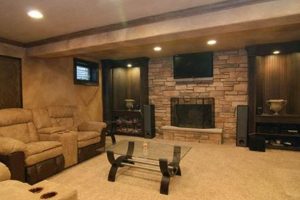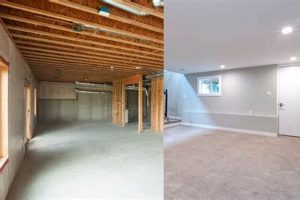Undertaking the completion of a lower-level space absent the necessary authorization signifies modifying residential property in contravention of established municipal or county regulations. For instance, concealing structural elements behind drywall before an inspection can lead to code violations and mandatory remediation.
The potential advantages, primarily cost savings and accelerated project timelines, are frequently overshadowed by considerable disadvantages. These encompass compromised safety standards, devaluation of property due to non-compliance, legal repercussions including fines and enforced alterations, and difficulties during property resale due to disclosure requirements and title issues. Historically, these actions have arisen from a desire to expedite home improvements or avoid perceived bureaucratic obstacles.
Subsequent sections will delve into the specific risks associated with unauthorized construction, detail the process for obtaining proper approvals, explore options for rectifying unpermitted work, and examine the long-term implications for homeowners.
Considerations Regarding Unpermitted Basement Finishing
The following information presents crucial factors to contemplate prior to proceeding with the modification of a lower level in the absence of proper authorization.
Tip 1: Assess Potential Risks. A comprehensive evaluation of possible dangers is paramount. These include structural deficiencies that remain undetected without inspection, fire safety hazards arising from non-compliant wiring or inadequate egress, and moisture-related problems that can foster mold growth and compromise air quality.
Tip 2: Understand Code Compliance. Familiarization with local building regulations is essential. Requirements dictate minimum ceiling heights, proper insulation, electrical grounding, ventilation, and emergency escape routes. Non-compliance can necessitate costly rework to bring the space up to standard.
Tip 3: Evaluate Long-Term Property Value. While immediate cost savings might seem attractive, the absence of permits can negatively impact the resale value. Potential buyers may be hesitant to purchase a property with unapproved alterations, and lenders might be unwilling to provide financing until the issues are resolved.
Tip 4: Review Insurance Implications. Failure to disclose unpermitted work can invalidate insurance coverage in the event of a fire, flood, or other disaster. Insurance companies may deny claims if the modifications violate building codes or pose an increased risk.
Tip 5: Research Retrospective Permitting. If work has already commenced or been completed, investigate the feasibility of obtaining permits retroactively. This process involves submitting plans, undergoing inspections, and making any necessary corrections to ensure compliance.
Tip 6: Obtain Professional Consultation. Engaging qualified architects, engineers, or contractors is advisable. They can assess the existing conditions, identify potential code violations, and develop a plan for remediation or permit acquisition.
Ultimately, careful consideration of the aforementioned points is critical. Pursuing proper authorization channels is the most prudent path.
Subsequent sections will discuss the legal and financial consequences of non-compliance, along with available resources for homeowners seeking to address unpermitted construction.
1. Code Violations
The absence of adherence to established building regulations is a central characteristic of finishing a basement absent proper authorization. These regulations, commonly referred to as building codes, are designed to ensure the safety, structural integrity, and habitability of residential structures. Initiating or completing construction activities without obtaining the requisite permits circumvents the review and inspection processes intended to verify compliance with these codes, invariably leading to potential violations. These violations may range from inadequate ceiling heights and insufficient emergency egress to non-compliant electrical wiring and improper structural support.
The consequences of code violations within an unpermitted basement finishing project are significant. For example, inadequate ventilation can lead to moisture buildup and mold growth, negatively impacting air quality and potentially creating health hazards. Non-compliant electrical work increases the risk of electrical fires, jeopardizing the safety of the occupants. Structural alterations without proper engineering review may compromise the building’s load-bearing capacity, potentially resulting in collapse. Moreover, even seemingly minor infractions can trigger mandatory remediation, requiring costly and disruptive rework to bring the space into compliance. Instances abound where homeowners have been forced to demolish substantial portions of unpermitted basement finishes due to uncorrectable code violations.
Understanding the connection between code violations and unauthorized basement finishing is of practical importance for homeowners considering or having already undertaken such a project. It underscores the necessity of adhering to established building regulations, not simply as a matter of legal compliance, but also as a crucial step in ensuring the safety, longevity, and value of the property. Rectifying code violations discovered after the fact can be far more expensive and complicated than obtaining the necessary permits and inspections before commencing construction. Therefore, diligent adherence to code requirements is paramount when converting any space into a habitable area.
2. Safety Compromised
Completing a basement transformation without proper authorization inherently elevates risks to occupant well-being. The formal permitting process necessitates inspections by qualified professionals who scrutinize construction for adherence to established safety codes. Circumventing this process means potential hazards may remain undetected, directly impacting the safety of those occupying the space. For instance, inadequate fire-resistant materials can accelerate fire spread, while insufficient emergency exits can impede escape during a crisis. The absence of proper ventilation can lead to the accumulation of harmful gases such as radon, posing a long-term health risk to inhabitants. Real-world examples abound where unpermitted basement modifications have resulted in tragic consequences due to undetected safety deficiencies.
Furthermore, compromised electrical systems are a common consequence. Unpermitted electrical work, often performed without the requisite knowledge or adherence to code, can lead to overloaded circuits, improper grounding, and exposed wiring. These conditions significantly increase the risk of electrical shock and fire. The installation of plumbing without proper backflow prevention devices can contaminate the potable water supply, posing a serious health hazard. The structural integrity of the basement may also be at risk. The removal or alteration of load-bearing walls without appropriate reinforcement can compromise the stability of the entire building, potentially leading to catastrophic collapse. These concerns underscore the practical significance of professional oversight during basement finishing projects.
In summary, bypassing the permitting process introduces a multitude of safety risks that can have severe and lasting consequences. Ignoring safety protocols to cut costs or expedite timelines is a false economy, potentially endangering lives and property. A thorough understanding of the safety implications associated with unauthorized basement finishing is essential for homeowners to make informed decisions and prioritize the well-being of themselves and their families. The long-term costs of rectifying safety deficiencies far outweigh any perceived short-term savings gained by avoiding proper permitting and inspections.
3. Property Devaluation
The diminution of a property’s assessed or market value is a tangible risk when improvements, particularly basement finishing, are undertaken without appropriate permits. This devaluation stems from a convergence of factors that impact both the perceived and actual worth of the real estate.
- Lack of Official Recognition
Unpermitted improvements lack official recognition from municipal or county authorities. This absence of formal acknowledgement creates uncertainty regarding code compliance, structural integrity, and overall safety. Potential buyers often perceive this as a liability, leading to a reduced willingness to pay comparable prices for the property. Lenders may also be hesitant to finance a property with unpermitted work, further limiting the pool of potential buyers.
- Increased Liability and Remediation Costs
The presence of unpermitted work introduces potential legal and financial liabilities. Buyers may be concerned about being held responsible for rectifying code violations or structural deficiencies discovered after the purchase. The anticipated costs of bringing the unpermitted space into compliance can significantly impact the buyer’s offer price. Moreover, the necessity of demolition or extensive rework to achieve compliance represents a substantial economic disincentive.
- Disclosure Requirements and Negative Perceptions
Sellers are typically legally obligated to disclose the existence of unpermitted work to potential buyers. This disclosure can create negative perceptions, even if the work itself is of high quality. The mere fact that improvements were made without proper oversight raises concerns about potential hidden problems. Buyers may perceive the seller as having attempted to circumvent regulations or cut corners, further eroding confidence in the property’s value.
- Appraisal Discrepancies and Market Comparability
Appraisals are a crucial component of real estate transactions, and unpermitted work can create significant discrepancies in the assessed value. Appraisers may not be able to fully account for the value of an unpermitted basement finish due to the lack of official documentation and uncertainty regarding compliance. This can lead to a lower appraisal, impacting the loan amount and ultimately the sale price. Furthermore, comparing the property to similar properties with permitted basement finishes becomes problematic, as the unpermitted work introduces an element of incomparability.
The cumulative effect of these factors demonstrates that improvements to a property, specifically completing a basement without following the proper authorization protocols, can significantly detract from its overall value. Addressing these concerns proactively, through proper permitting and inspections, represents a critical step in safeguarding the long-term financial investment in the property. Furthermore, attempting to rectify unpermitted work after the fact often proves more expensive and time-consuming than obtaining the necessary approvals in the first instance.
4. Legal Penalties
Engaging in unauthorized basement finishing invariably exposes property owners to a spectrum of legal penalties imposed by local municipalities and governing bodies. These penalties are a direct consequence of circumventing established building codes and permitting procedures designed to ensure public safety and structural integrity. The severity of these penalties can vary significantly depending on the jurisdiction, the nature of the violations, and the homeowner’s response to official notices. Financial fines represent a common form of legal consequence, often escalating with each day of non-compliance. In egregious cases, municipalities may pursue legal action demanding the removal of the unpermitted improvements, necessitating costly demolition and restoration to the original state. For instance, several jurisdictions mandate fines ranging from hundreds to thousands of dollars per day for uncorrected code violations discovered in unpermitted construction.
Beyond monetary penalties and demolition orders, additional legal ramifications can arise. Municipalities may place liens on the property to secure payment of fines or the cost of remediation performed by the city. These liens can complicate or prevent property sales until the outstanding debts are settled. Furthermore, unpermitted construction can trigger increased property tax assessments, as the improved square footage becomes subject to taxation without the proper permits. In certain instances, homeowners may face misdemeanor charges for knowingly violating building codes, leading to potential criminal records. Illustratively, homeowners who intentionally conceal unpermitted work during property sales may be subject to fraud charges, carrying significant legal consequences. Furthermore, the discovery of unpermitted work can invalidate homeowner’s insurance policies, leaving the property owner financially vulnerable in the event of a fire or other disaster.
In summary, understanding the legal penalties associated with unauthorized basement transformations is of paramount importance. These penalties represent a significant financial risk and can lead to severe legal consequences, including fines, property liens, demolition orders, and even criminal charges. Proactive compliance with building codes and permitting procedures is essential to avoid these potential legal pitfalls and protect the long-term value and safety of the property. Homeowners contemplating basement finishing should prioritize obtaining the necessary permits and inspections to ensure adherence to all applicable regulations, mitigating the risk of facing costly legal ramifications.
5. Insurance Voided
The connection between unauthorized basement improvements and the potential nullification of homeowner’s insurance coverage represents a substantial financial risk. Standard homeowner’s insurance policies are predicated on the accurate representation of a property’s features and compliance with local building codes. Undertaking a significant renovation, such as completing a basement, fundamentally alters the property’s characteristics. Consequently, failure to disclose the alteration and obtain the necessary permits creates a discrepancy between the insurer’s understanding of the property and its actual state.
This discrepancy can lead to claim denials in the event of damage. For instance, if a fire originates in an unpermitted basement due to faulty wiring, an insurer might refuse coverage, citing the undisclosed renovation and associated code violations. Similarly, water damage resulting from improper plumbing installed during the unpermitted basement finishing could result in denied claims. Insurance companies often argue that unpermitted work increases the risk profile of the property without their knowledge or consent, justifying the voiding of coverage. Numerous documented cases exist where homeowners have been denied insurance claims due to unpermitted basement modifications, resulting in significant financial losses. Furthermore, even if a claim is initially approved, the insurer may subsequently discover the unpermitted work during the claims investigation process, retroactively voiding the coverage and demanding reimbursement of previously paid funds.
Understanding the potential for insurance invalidation is crucial when considering or having completed a lower-level finishing project. Homeowners are encouraged to proactively disclose any modifications to their insurance providers and ensure compliance with all local permitting requirements. This proactive approach not only safeguards against potential claim denials but also mitigates the financial risk associated with uninsured damage. Verifying insurance coverage adequacy and compliance with building codes is essential for protecting a property’s value and the financial well-being of its owners.
6. Resale Difficulties
The complications that arise during the sale of a property featuring a completed lower level lacking proper authorization represent a significant impediment for homeowners. These difficulties stem from a confluence of factors related to legal compliance, buyer perception, and financial considerations.
- Title Defects and Disclosure Requirements
The existence of unpermitted work creates a title defect, requiring disclosure to prospective buyers. Such disclosure raises concerns regarding potential code violations and the structural integrity of the finished space. Buyers may be wary of assuming responsibility for rectifying unpermitted modifications, leading to reluctance or reduced offers.
- Financing Obstacles for Buyers
Lenders often require appraisals to ensure the property’s value supports the loan. An appraiser may not fully value an unpermitted basement finish, leading to a lower appraisal and potentially preventing the buyer from securing financing. This limitation restricts the pool of potential buyers to those with substantial cash reserves or those willing to undertake the risk of obtaining financing despite the unpermitted work.
- Increased Scrutiny During Inspections
Home inspections typically uncover unpermitted modifications, prompting further investigation by prospective buyers. The inspection report may highlight code violations or safety concerns, necessitating repairs or remediation. Buyers may demand price reductions or refuse to proceed with the purchase until the seller addresses these issues.
- Liability and Legal Recourse
Buyers may pursue legal recourse against sellers who fail to disclose unpermitted work or misrepresent the status of the basement finish. Litigation can be costly and time-consuming, resulting in financial losses and reputational damage for the seller. Furthermore, the discovery of unpermitted work may trigger municipal inspections and enforcement actions, requiring costly remediation or demolition.
These interconnected challenges underscore the negative impact of unpermitted basement finishes on property sales. Overcoming these difficulties often necessitates costly remediation, significant price reductions, or protracted legal battles. Obtaining proper permits and inspections prior to undertaking such projects is a prudent approach to mitigating these potential resale complications.
Frequently Asked Questions
The following addresses common inquiries regarding the implications of completing a basement project absent proper authorization.
Question 1: What constitutes “finishing” a basement in the context of requiring permits?
Transforming an unfinished basement into a habitable space generally necessitates permits. This includes activities such as installing drywall, adding electrical wiring, introducing plumbing fixtures, and creating finished flooring. Minor cosmetic upgrades, such as painting or adding non-structural decorations, may not require permits but should be verified with local authorities.
Question 2: Is it possible to obtain permits retroactively for work already completed?
Obtaining permits retroactively, often referred to as “after-the-fact” permits, is feasible in some jurisdictions. This process typically involves submitting plans of the completed work, undergoing inspections to ensure code compliance, and potentially rectifying any identified violations. Approval is not guaranteed, and significant remediation may be required.
Question 3: What is the typical timeframe for obtaining necessary permits for basement finishing?
The timeframe for permit acquisition varies depending on the municipality, the complexity of the project, and the backlog of applications. It can range from several weeks to several months. Accurate and complete documentation can expedite the process. Consulting with local building officials is advisable to determine specific timelines.
Question 4: Are there specific instances where permits are not required for basement finishing?
While uncommon, some jurisdictions may exempt certain minor renovations from permit requirements. Examples might include replacing existing fixtures without altering the plumbing or electrical systems or installing non-load-bearing partitions. However, it is imperative to verify such exemptions with local building departments prior to commencing any work.
Question 5: How does unauthorized basement finishing affect property taxes?
Unpermitted basement modifications may result in property tax reassessments upon discovery by local authorities. The increased habitable square footage will likely lead to a higher assessed value, resulting in increased property tax liabilities. Failure to report such modifications may be considered tax evasion, potentially leading to additional penalties.
Question 6: What steps should be taken if unpermitted work is discovered during a home inspection?
If unpermitted work is identified during a home inspection, it is essential to consult with legal counsel and qualified contractors. Options include obtaining permits retroactively, negotiating remediation with the buyer, or reducing the sale price to reflect the cost of bringing the space into compliance. Disclosure and transparency are crucial to avoid potential legal disputes.
Proper authorization and inspections are essential for ensuring safety, code compliance, and long-term property value.
The subsequent section will outline resources available to homeowners considering or dealing with unpermitted basement construction.
Conclusion
The preceding exploration has detailed the multifaceted ramifications of finish basement without permit. From code violations and safety compromises to property devaluation, legal penalties, and insurance invalidation, the risks associated with circumventing established building regulations are substantial. The practice introduces long-term financial and legal vulnerabilities that significantly outweigh any perceived short-term cost savings.
Prudent property management necessitates adherence to all applicable building codes and permitting procedures. Homeowners contemplating lower-level modifications are strongly advised to prioritize compliance to safeguard their investment, ensure occupant safety, and avoid potentially severe legal and financial repercussions. Diligence in seeking proper authorization is not merely a formality but a critical element of responsible property ownership.







